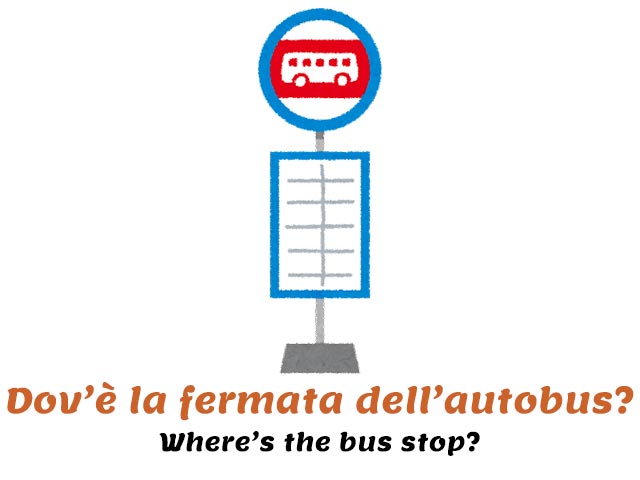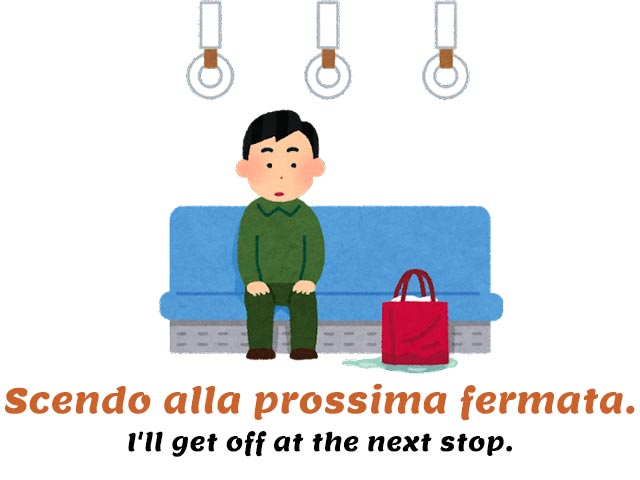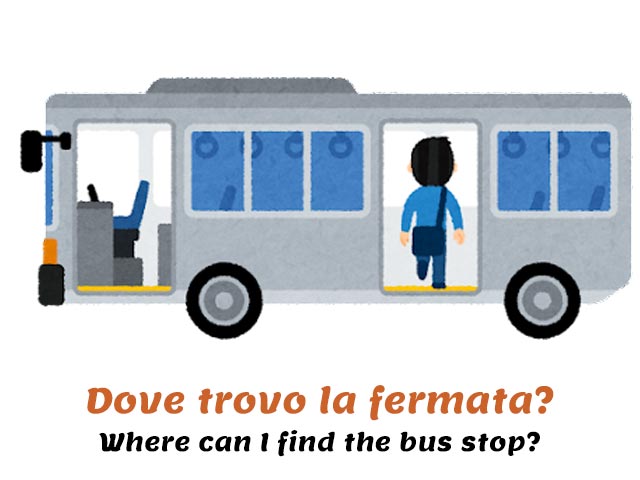How exactly do you say where is the bus stop in Italian?
In this lesson, we will take a look at the different ways you can translate this sentence into Italian. Read on to learn them all!
La fermata dell’autobus
The bus stop
Let’s get started! Iniziamo!
How do you say where is the bus stop in Italian?
Dov’è la fermata?
Dov’è la fermata dell’autobus? is the most common translation for where is the bus stop into Italian.
Dov’è la fermata dell’autobus?
Where is the bus stop?

This common sentence in Italian is made up of three elements.
Dove
Where
È
Is
La fermata dell’autobus
The bus stop
Mi scusi, mi sa dire dov’è la fermata dell’autobus?
Excuse me, can you tell me where the bus stop is?
È comes from essere, to be, which is an irregular verb and it belongs to the second -ere group. Its indicativo presente conjugation is as follows.
Present tense conjugation for essere
| io | sono |
| tu | sei |
| lui, lei | è |
| noi | siamo |
| voi | siete |
| loro | sono |
Title: Italian All-in-One For Dummies
Language: English / Italian
Publisher: For Dummies
Pages: 672
Learn to speak Italian like a native? Easy.
Italian All-in-One For Dummies appeals to those readers looking for a comprehensive, all-encompassing guide to mastering the Italian language. It contains content from all For Dummies Italian language instruction titles, including Italian For Dummies, Intermediate Italian For Dummies, Italian Verbs For Dummies, Italian Phrases For Dummies, Italian Grammar For Dummies, and Italian For Dummies Audio Set.
For example, you could say…
Il gatto è sul davanzale della finestra.
The cat is on the windowsill.
Prima siamo andati al museo, poi siamo tornati al parco.
First, we went to the museum, then we went back to the park.

La fermata is a feminine noun derived from the verb fermare, meaning to stop. Then you have autobus, which obviously means bus.
Una fermata
A stop
Delle fermate
Some stops
La fermata
The stop
Le fermate
The stops
Bus stop can be translated simply as fermata, because this word is also used to mean any kind of public vehicle stops on the road.
There’s more than one kind of fermata and some of them are…
La fermata del treno
The train stop
La fermata del tram
The tram stop
La fermata di servizio
The service stop
For example, you could say…
Sono alla fermata del tram e sto aspettando ormai da mezz’ora.
I am at the tram stop and have been waiting for half an hour now.
Scendo alla prossima fermata.
I’ll get off at the next stop.
Did you know? The movie Fried Green Tomatoes was translated into Italian as Pomodori verdi fritti alla fermata del treno (fried green tomatoes at the train stop)!

Dove trovo la fermata?
Instead of essere, the question where is the bus stop? can also be expressed in Italian with the verb trovare, which means to find. This is a regular verb and the following table shows its present tense conjugation, which we will use to translate our sentence.
Present tense conjugation for trovare
| io | trovo |
| tu | trovi |
| lui, lei | trova |
| noi | troviamo |
| voi | trovate |
| loro | trovano |
To ask where is the bus stop in Italian, say…
Dove trovo la fermata dell’autobus?
Where can I find the bus stop?

As you can see, you are literally asking where do I find…?. You can use this instead of dov’è la fermata?, it has the same meaning and is completely interchangeable.
Dove si trova la fermata?
There are actually three different ways to say where the bus stop is in Italian.
The third and last way to say where is the bus stop in Italian is with the reflexive verb trovarsi, to find oneself. This is a bit different from trovare, although the conjugation is much the same and just adds object pronouns to the verb (I find myself, you find yourself, etc.).
| io | mi trovo |
| tu | ti trovi |
| lui, lei | si trova |
| noi | ci troviamo |
| voi | vi trovate |
| loro | si trovano |
Trovare means “to come across an object”. It’s an active verb.
Ho trovato gli occhiali, erano sul tavolo.
I found the glasses; they were on the table.
Trovarsi means “to be located”. It’s a stative verb.
La stazione si trova davanti alla tabaccheria.
The station is located in front of the tobacco shop.
This means that dove si trova…? means where is… located? You will also notice that the third person pronoun is used in this sentence because the subject is no longer “I” but the bus stop itself.
Dove si trova la fermata dell’autobus?
Where is the bus stop located?
If you want to be more polite, you can start the sentence with mi sa dire…?, which means can you tell me…?.
You don’t need to change the position of the verb.
Mi sa dire dov’è la fermata dell’autobus?
Can you tell me where the bus stop is?
Mi sa dire dove si trova la fermata dell’autobus?
Can you tell me where the bus stop is located?
And that’s the end of our lesson on how to say where is the bus stop in Italian in all its forms!
What next?
➡️ Learn other common Italian questions!
Now that you’ve seen how to say where is the bus stop in Italian, you might want to keep learning Italian online with these free Italian resources:
❤️ If you liked this lesson on how to say where is the bus stop in Italian, consider sharing it with your social media friends who are also studying Italian.




